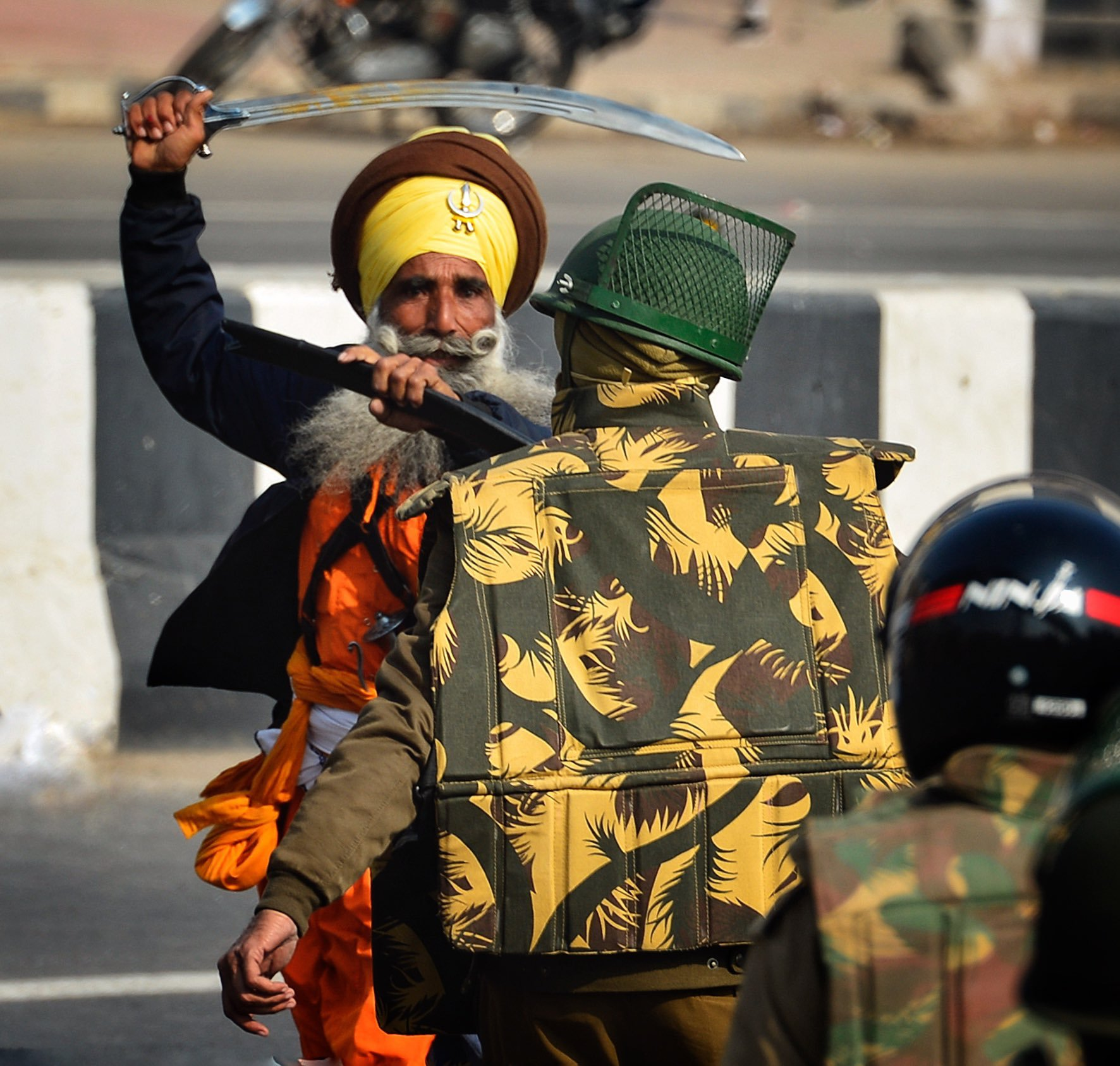

Protesters and fascists clash on India's Republic's Day.
In September 2020, India’s Parliament passed three “farm bills” intended to crush India’s workers. To serve capitalist interests, Prime Minister Narendra Modi, leader of the fascist Bharatiya Janata Party (BJP), lent his support to the bills depriving farms of current protections. He allowed corporate greed to further encroach on India’s agricultural sector.
On Nov. 26, 2020, in response to the government’s terror targeting the masses, workers launched a 250-million-strong, one-day general strike. In solidarity with fellow workers, thousands of Punjabi farmers marched to Delhi and created numerous protest sites on Delhi’s borders — including the Tikri, Ghazipur and Singhu borders — to demand the government repeal the anti-farmer laws. (Workers World, Dec. 1, 2020)
In maintaining their uncompromising principles and to put pressure on the oppressors, farmers launched another march to Delhi on Jan. 26, India’s Republic Day. An estimated 200,000 tractors along with tens of thousands of farmers were present at the rally. As demonstrators made their way to the capital, they were met with intense state-sponsored violence. Police placed barricades throughout the city, used tear gas and beat protesters to prevent them from entering Delhi. (The Wire, Jan. 26)
However, the farmers successfully breached the blockades and scaled the historic Red Fort, one of the sites where R-Day’s events were set to take place. Once within the Fort’s parameters, protesters hoisted the farmers’ union flag, the Indian flag and the Nishan Sahib (a flag of religious significance to Sikh communities). The events at the Fort demonstrated an assertion of identity — a refusal to allow the state to disappear the people.
As expected, the oppressor’s response came in the form of both physical and structural violence. On the day of the monumental rally, police shot and murdered Navneet Singh, then tried to conceal their homicidal act by telling reporters Singh’s death was due to his tractor toppling over. Police and BJP supporters attempted to forcibly remove protesters from their protest sites at the Ghazipur and Tikri borders. (The Wire, Jan. 30)
At the Singhu border, BJP supporters brutally attacked members of Kisan Mazdoor Sangharsh Committee, a union that was present at the tractor protest. To choke any expression of discontent and to prevent people from joining their fellow workers, India’s government suspended internet service at protest sites. (Al Jazeera, Jan. 29) Moreover, Twitter India suspended multiple accounts for several hours for reporting on the farmers’ protest. (The Wire News India, Feb. 1)
Although the state is desperately attempting to tighten control on the masses, it is clear that the power dynamics in India are beginning to shift. The farmers’ actions have sparked a movement, and the people are doing their part to ensure we achieve liberation.
Broad solidarity with farmers
At various protest sites, workers have offered sewa, mutual aid, to demonstrators. Rural India reports that there are an estimated 30 medical sites at Singhu border to ensure demonstrators have access to healthcare. (www.tinyurl.com/1gqfwbta) Doctors have set up medical camps to ensure protesters have access to health care. A village in Haryana sent a truck with solar panels and charging ports, which provides demonstrators with access to charge their phones. Additionally, people from Ludhiana have transported a huge sugarcane-crushing machine and offer fresh sugarcane juice to anyone who passes by.
Demonstrators have responded with their own acts of solidarity. Massive school closures attributed to the pandemic have greatly harmed children who do not have internet access. At Singhu border, protesters have converted some of their tents into classrooms to provide schooling to children who live in neighboring villages. That school has over 160 students, and demonstrators expressed that teaching children is important to the collective movement. (Al Jazeera, Jan. 22)
Acts of solidarity extend beyond India’s borders. In Pakistan, members of the Pakistan Kissan Rabita Committee organized a demonstration near the Wagah border, a checkpoint where millions of migrants crossed from India and Pakistan during the Partition of India in 1947. Those belonging to the South Asian diaspora have also shown solidarity with farmers in India. In Detroit, hundreds of people participated in a car caravan to express their connection to the protests.
In this movement, the people are united. The farmers’ and workers’ actions in India give us a chance to reimagine a world where the people are in power. The organizational strategies used to sustain the protests demonstrate the potential for building alternative infrastructures to ensure people get their needs met.
The symbolic solidarity in Pakistan allows the possibility of healing generational wounds inflicted by British imperialism. Protests led by South Asians around the world show that we all must engage in the collective struggle against fascism.
Deep solidarity with protesters in India; build a workers’ world!
This statement was recently issued by over 30 groups. On Friday, March 28, Dr. Helyeh…
When Donald Trump announced massive tariffs on foreign imports April 2, Wall Street investors saw…
The century-long struggle to abolish the death penalty in the U.S. has been making significant…
Download the PDF May Day appeal to the working class Revolutionary change is urgent! Gaza…
Philadelphia On March 26, the Pennsylvania Supreme Court denied political prisoner Mumia Abu-Jamal permission to…
There are two important and overlapping holidays on April 22: Earth Day and Vladimir Lenin’s…